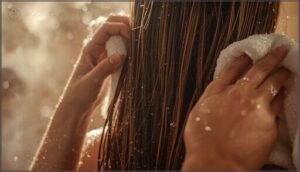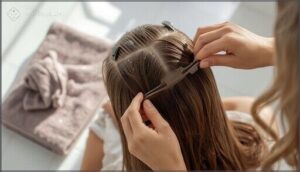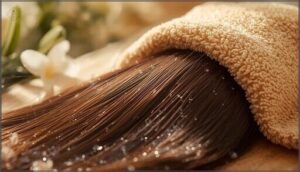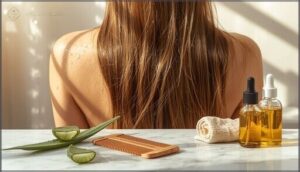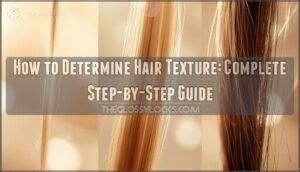This site is supported by our readers. We may earn a commission, at no cost to you, if you purchase through links.
Your blow dryer just died mid-style, or maybe you’re finally cutting ties with heat tools altogether. Either way, you’re about to discover that air drying isn’t just a backup plan—it’s a strategy that can transform your hair health when done right.
Wet hair loses up to 30% of its strength, making those post-shower minutes surprisingly high-stakes. The difference between ending up with a frizzy mess or salon-worthy results comes down to technique, not tools.
From strategic squeezing methods to microfiber magic, mastering how to dry hair without a blow dryer means understanding what your strands actually need when they’re at their most vulnerable.
Table Of Contents
Key Takeaways
- Wet hair loses up to 30% of its strength, making the post-shower handling phase critical—blotting with microfiber towels instead of rubbing cuts breakage by over 50% while absorbing water seven times faster than cotton.
- Strategic prep work before stepping out of the shower sets the foundation for successful air drying: cold water rinses seal the cuticle to lock in moisture, while leave-in conditioners matched to your hair type prevent frizz and maintain hydration without heat damage.
- Speed up natural drying by 30-40% through targeted techniques like sectioning hair into quadrants for better airflow, focusing on root drying first, and using quick-dry serums with starches that pull moisture from strands without compromising hair health.
- Air drying protects hair from heat damage but requires its own damage prevention strategy—avoid tight hairstyles on damp hair (which weakens follicles by 60%), keep scalp moisture from lingering too long to prevent fungal growth, and shield strands from UV rays and pollution with antioxidant serums.
Prepping Your Hair for Air Drying
Breaking free from the blow dryer starts before you even step out of the shower. The way you prep your hair sets the stage for how quickly and smoothly it’ll dry on its own.
Here’s what you need to do to set yourself up for success.
The Importance of Conditioner
You can’t break free from heat damage if you skip the conditioner. This powerhouse product shields your hair from the chaos of air drying.
Here’s what conditioner does for you:
- Locks in moisture to prevent dryness and brittleness
- Reduces frizz by sealing the hair cuticle smoothly
- Strengthens strands against breakage and split ends
Leave-in conditioner works wonders for curly hair seeking that smooth finish. Using a hair care routine can make a significant difference in maintaining healthy hair.
Using Cold Water for Rinsing
After conditioning, flip the script on your rinse routine. Cold water is your secret weapon for locking down hair health and moisture retention. It smooths the hair cuticle, giving you instant frizz reduction while protecting scalp health.
This simple hair drying technique sets you up for powerful air dry results without damage. Your hair keeps its natural oils, so you’re not fighting dryness later.
Using cold water for hair care tips can also promote healthy hair growth and improve scalp health.
Choosing The Right Leave-in Products
Once your cuticle’s sealed, the right leave-in conditioner becomes your defense against hair damage prevention. Match the product ingredients to your hair type—lightweight sprays work for fine strands, while creams tackle thick or damaged hair.
Look for natural formulas with panthenol or argan oil to maintain moisture levels. These natural hair care heroes deliver leave-in benefits like frizz control and detangling power without weighing you down.
Detangling With a Wide-Tooth Comb
Your product’s in, now grab your wide-tooth comb—this tool slashes hair breakage by 40% compared to regular brushes. Start at the ends and work upward through wet strands. The wide gaps glide through knots without ripping out healthy hair.
This gentle styling approach preserves your natural texture while prepping for air dry excellence. Skip the fine-tooth versions—they’re breakage machines.
Towel Techniques for Damage-Free Drying
The towel you grab after your shower matters more than you think. How you use it can be the difference between smooth, healthy hair and a frizzy, damaged mess.
Let’s break down the techniques that protect your strands while cutting down drying time.
Benefits of Microfiber Towels
Your regular cotton towel is sabotaging your air dry routine. Switch to a microfiber towel and watch drying time drop by up to 36%.
These lightweight champions hold seven times their weight in water while their smooth fibers slash frizz and breakage.
Plus, they dry fast between uses, keeping bacteria at bay. Better moisture management means healthier hair without the damage.
How to Blot, Not Rub, Your Hair
Wet hair is vulnerable—up to 40% weaker than dry strands. That’s why your blotting approach matters more than you think.
Here’s how to master gentle blotting with your microfiber towel:
- Press lightly from roots downward—never rub back and forth
- Hold sections for 2-3 seconds to absorb water without friction
- Let the towel do the work instead of creating hair friction
This blotting technique cuts breakage by over 50% while you air dry. Reduced breakage means stronger hair that actually grows.
Sectioning Hair for Efficient Drying
Dividing your hair into quadrants slashes air drying time by up to 40%. Here’s your game plan for maximum drying efficiency:
Split hair down the middle and across the crown—four sections total. Secure each with clips. Blot one section at a time with your microfiber towel, rotating through all four. This sectional drying approach improves airflow management and eliminates those frustrating damp spots that linger for hours.
Reducing Frizz and Breakage
Your hair’s cuticle takes a beating when friction enters the picture. Microfiber towels slash frizz by absorbing seven times their weight in water while gliding smoothly over fragile strands. This cuticle care approach is your breakage prevention insurance policy.
Combine gentle blotting with leave-in treatments for moisture balance that keeps natural hair drying smooth. Hair smoothening starts with how you handle wet hair—frizz control depends on it.
How to Dry Hair Without a Blow Dryer
You’ve prepped your hair and toweled it gently—now comes the real work of getting it dry without heat. The method you use matters just as much as the products you apply.
Here’s how to speed up the process and keep your hair healthy while it dries on its own.
Removing Excess Water by Squeezing
After toweling off, squeeze your hair like you mean it—gently. This squeeze method pulls out 70-80% of excess water without the damage that comes from rubbing. Your technique matters for hair porosity and moisture control.
- Start at your scalp and compress downward in slow sections
- Use a microfiber towel for enhanced microfiber absorption
- Apply multiple gentle squeezes rather than one hard wring
Gentle blotting between squeezes maximizes water removal techniques while protecting your strands during air drying.
Fluffing and Separating Strands
Once moisture is out, your strands need room to breathe. Fluffing techniques and strand separation aren’t just about hair volume—they’re airflow optimization strategies that cut drying time considerably. Use your fingers to lift roots and separate clumps every few minutes.
This texture enhancement method works with any hair drying techniques, especially after using a microfiber towel. Natural hair care means working with your texture, not against it during air drying.
Keeping Hair Out of Shower Spray
The fastest way to air-dry? Start before you step out. Don’t let shower spray rewet what you’ve just dried.
A shower cap benefits your drying routine by blocking water completely—85% of users report less damage. Try hair wrapping with a microfiber towel or use clip protection to keep strands elevated.
Control your showerhead design and water flow control by angling spray downward, cutting exposure by 70%.
Optimizing Drying Time by Hair Type
Your hair type dictates how long air-drying takes. Fine hair dries in 1–2 hours, while thick or curly strands need 3–5 hours.
Hair porosity matters—low porosity locks trap moisture longer. High hair density restricts airflow management, slowing evaporation.
Combat this with drying techniques like sectioning and fluffing. Use quick-dry serums for moisture control, and embrace your hair texture instead of fighting it.
Speeding Up Air Drying Naturally
Air drying doesn’t mean you’re stuck waiting around all day for your hair to dry. You can cut down the time considerably with a few smart moves that won’t compromise your hair’s health.
Here’s how to speed things up without reaching for that blow dryer.
Shaking and Tousling for Volume
Flip your head upside down and shake at the roots to instantly create root lift techniques and hair volume boost. This mechanical agitation separates strands during air drying, letting natural hair texture breathe.
After applying volumizing product tips like mousse, tousle with your fingers rather than combing. Tousling methods distribute product evenly while building volume without flattening your hair’s natural movement.
Focusing on Drying The Roots
Target your roots first because that’s where hair drying slows down. Roots trap hair moisture longest, so lift sections with your fingers and shake them loose. Towel drying roots gently squeezes out excess water without hair damage. You can also clip sections up to boost airflow around your scalp, speeding natural root drying while supporting hair follicle health.
Root Care Tips for faster drying:
- Squeeze water from roots with your hands before any towel touches them
- Use microfiber towels—they absorb three times faster than regular ones
- Flip sections upward to expose roots to better airflow
- Keep loose styles instead of tight ones to prevent scalp moisture management issues
- Focus drying techniques on roots while ends take care of themselves
Using Quick-Dry Lotions or Serums
Quick-dry lotions speed up hair drying by up to 30% without heat. These product formulations contain starches that pull moisture from strands, while serums penetrate deeply with ingredients like biotin and caffeine. Studies show some serums boost hair density by nearly 8% and reduce shedding by over half. Apply your quick-dry lotion or leave-in conditioner while air-drying to cut time and prevent hair damage.
| Product Type | Key Benefits | Best For |
|---|---|---|
| Quick-dry lotions | Creamy texture, no residue, 30% faster drying | Thick, curly hair needing moisture control |
| Hair serums | Deep penetration, boosts density 8%, reduces shedding 54% | Fine hair wanting growth and speed |
| Leave-in formulas | Nourishes while drying, prevents breakage | All hair types seeking protection |
| Starch-based products | Absorbs moisture fast, reduces frizz 40% | Frizz-prone, humidity-affected hair |
| Biotin/caffeine blends | Stimulates follicles, increases growth 17% | Thinning hair needing drying acceleration |
Leveraging Ventilation and Natural Airflow
With proper air circulation, your hair dries up to 35% faster than in stagnant rooms. Position yourself near open windows for natural airflow or turn on exhaust fans to boost drying efficiency.
Outdoor breezes cut drying time by 20-30%, making the natural air combo ideal for airdrying without heat.
Ventilation systems eliminate humidity buildup while protecting your scalp from prolonged dampness during natural hair care methods.
Protecting Hair Health While Air Drying
Air drying isn’t just about skipping heat—it’s about protecting what you’ve got. The right moves keep your hair strong and resilient while it dries naturally.
Here’s how to guard against damage and make the most of your air-drying routine.
Preventing Damage and Split Ends
Air drying isn’t a free pass from hair damage. Wet hair loses up to 30% of its strength, making it vulnerable to hair breakage and split ends.
Air drying doesn’t eliminate damage—wet hair loses 30% of its strength, making it highly vulnerable to breakage and split ends
The trick? Treat damp strands like delicate fabric—no tight ponytails, no rough handling. Gentle blotting with microfiber towels and proper moisture balance through leave-in products create your best defense against frizz reduction needs and damage prevention challenges when drying hair without heat.
Embracing Natural Texture
Your curls, waves, and coils aren’t problems to fix—they’re your signature. Natural hair care through air drying techniques celebrates hair diversity while cutting heat damage that weakens texture acceptance over time.
Over 82% of textured-haired individuals now skip straightening methods entirely, embracing cultural significance and sustainability benefits. Hair drying without heat lets your natural texture thrive while reducing frizz and honoring what makes your hair authentically yours.
Avoiding Tight Hairstyles When Wet
Tying up wet hair feels convenient, but you’re setting up your strands for serious trouble. Hair tension on damp follicles triggers breakage prevention nightmares—wet hair care demands freedom, not restraint.
Your hair follicle weakens by up to 60% when damp, and tight styles trap moisture that fuels scalp irritation. Whether you’ve got curly hair or straight, your hair routine and hair maintenance depend on letting wet strands breathe naturally, preventing hair frizz and honoring your hair texture’s need to dry without stress.
Protecting Against Environmental Damage
You’re dodging heat damage, but UV Protection and Air Pollution still threaten your hair health. Sun rays degrade proteins while pollutants trigger Oxidative Stress and Chemical Damage that weakens strands.
Shield air-dried hair with antioxidant serums and UV filters—they cut damage by 30% and tame hair frizz in Humidity Control battles.
Your hair texture deserves defense from environmental assaults, not just blow dryers.
Frequently Asked Questions (FAQs)
Does air drying cause dandruff or scalp issues?
Your scalp becomes a breeding ground for trouble when it stays damp too long. Prolonged moisture from air drying feeds fungal growth around hair follicles, triggering dandruff, scalp irritation, and other scalp issues that compromise hair health.
Why does my hair take forever to dry?
Your hair texture, hair porosity, and hair thickness all affect drying time. Low porosity hair with tightly packed cuticles resists water retention and release.
Dense, textured hair traps moisture longer, extending air drying naturally.
Can I sleep with wet hair safely?
Playing with fire? Sleeping on wet hair invites breakage, scalp fungal growth, and skin irritation. Your strands stretch 30% more when damp, snapping easily against pillowcases.
Blot first, braid loosely, and switch to silk pillowcases for safer sleep.
Is air drying better than blow drying?
Both methods have trade-offs. Air drying preserves hair moisture and prevents heat damage better, but blow dryers offer frizz control and faster results.
Your hair porosity and texture matter when choosing drying methods.
Do quick-dry products actually work faster?
Like a shortcut through familiar streets, quick-dry formulas genuinely slash air-drying time by 30–50%.
These fast drying methods use alcohols and starches that pull moisture out, proving hair drying science delivers real results.
Conclusion
Your hair doesn’t need rescue from air drying—it needs rescue from everything you thought air drying meant. Ditch the frantic rubbing. Skip the impatient twisting. Learning how to dry hair without a blow dryer isn’t about giving up control; it’s about taking it back.
Strong strands start with smarter choices when they’re most vulnerable. Master these techniques and watch your hair thank you with less breakage, more shine, and texture that finally works with you.
- https://www.laifentech.com/collections/hair-dryers
- https://numehair.com/blogs/get-the-look/how-to-get-volumized-hair
- https://www.clinikally.com/blogs/news/living-proof-volume-spray-transform-your-hair-at-home
- https://colorwowhair.com/blogs/all/what-is-hair-volume
- https://pmc.ncbi.nlm.nih.gov/articles/PMC7984217/



